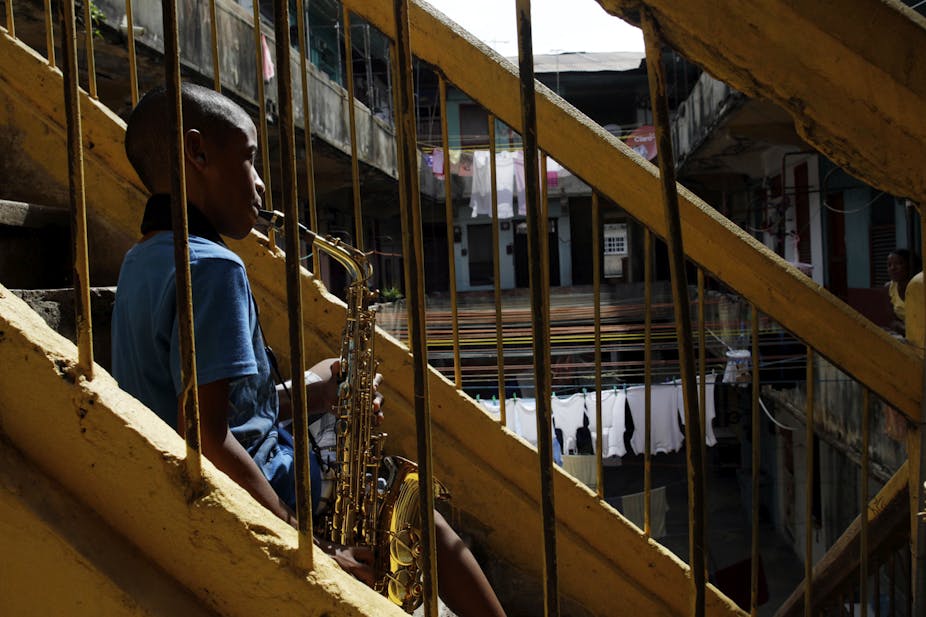The popular belief is that classical music is the best tool for early childhoood education. Jazz fan, music educator and lecturer Mignon van Vreden was convinced jazz would also work. So she launched a pilot project she called “Bejazzled” in a township preschool. She explained to The Conversation Africa’s arts and culture editor, Charles Leonard, that there’s a bright future for jazz in the classroom.
Why did you choose jazz?
Researchers have done a lot of work on this. They’ve compared classical music to rock music to heavy metal to jazz. Some researchers came to the conclusion that it’s not really about the style of the music but the type of music, type of instruments, the tempo of the music and the different timbres. So I thought jazz could also work as well, if not better.
All over the world people are using jazz for early childhood education. I really think it is evolving but it needs to be expanded in South Africa – people need to be introduced to jazz more.
How did the project come about and how did it work?
I did my PhD on music integration in Grade R [the South African school year in which learners turn five], so I’ve done a lot of research and a lot of work in the field – and I’ve been inspired by generalist educators in the field who already teach a lot of music with or without training.
From my research, a conceptual model evolved on ways to integrate music – so it’s not so much about the type of music, any music could be integrated into the curriculum. Because I’m a jazz lover I thought I could just as well combine the two and see if it works. One of the questions of this research is: can jazz as a genre be applied in preschool education?
I know the organiser of a programme funded by the Bafenyi Trust – it is involved in about 60 schools in the local African township of Ikageng in Potchefstroom [a university town 120km west of Johannesburg]. I spoke to her about this vision – to incorporate music into the schools. It includes training the teachers too, so that they can apply the training even if they don’t have any musical background. I planned a six-week cycle including different elements of jazz that I wanted to integrate.
Take us into the class.
It was wonderful; it was inspiring. I got there and the children were really excited – they wanted to do this. At first I asked them to sing some songs they know and like – they sang English songs with the teacher, then they sang Setswana songs. I then introduced myself, the teacher introduced herself and the kids introduced themselves, and I started to sing the song Fly Me to the Moon.
I used my own version – just singing it to them so that they could get a better idea of what it sounds like.
The kids obviously know the moon. They know what it does and how it works. We spoke about the people who landed on the moon – the Frank Sinatra version of the song was also played for the Apollo astronauts. Then they started to learn the song.
I spoke in English and the teacher translated each sentence into Setswana. We started with the singing, finger snapping, hand clapping, stamping their feet, body percussion. After that dance steps – simplified versions of jazz dance moves.
Later we made our own instruments – we had containers that we filled with three different things: rice, stones and sugar. So we had three different tone colours. And the kids played different jazz rhythms on these “instruments” and combined that with the singing.
What are the benefits for the children?
Early childhood learning should always focus on play – that is the main job of a preschooler. The best learning takes place when kids are playing. Music is a very playful aspect that they can use. It helps with musical development and with coordination, especially the dancing. Singing in tune develops their inner ear. Rhythms help them to count. Music enriches their lives in many ways.
Jazz is also about improvisation – could you apply it in your project?
In the last lesson we had a concert – the kids did all they wanted to do on the song Fly Me to the Moon in their own ways. So the improvisation came out not in the way I suspected it would, but it came out in their own way. So it was proper improvisation.
What did you want to achieve with it?
Seeing that it was a pilot study, I wanted to see if the project could work. It was also to equip teachers without musical training with musical knowledge and skills that they can use in their classrooms, to enrich the learners’ lives with jazz music and to introduce them to jazz.
I can say the pilot study was successful in that I can go further with this project.
What next?
I want to build on the pilot study and find out from the teacher what worked for her, how she experienced it, what she wants to apply – then work together with her and see where that goes. Then hopefully we can expand the project and get more teachers on board.
What other jazz tunes will work when the pilot continues?
Pennies from Heaven by Frank Sinatra, Herbie Hancock’s Watermelon Man and Super Duck by Elena Cobb. Their lyrics, simpler melodies, singable rhythms and correct duration for toddlers’ attention span make these songs toddler friendly.

